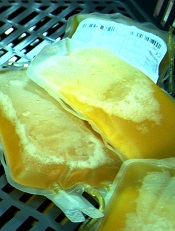
Photo by Cristina Granados
Health Canada has approved the INTERCEPT Blood System for plasma, a pathogen inactivation system used to reduce the risk of transfusion-transmitted infections.
The system can be used to reduce pathogens in plasma derived from whole blood or obtained by apheresis.
The system inactivates pathogens through a photochemical process involving controlled exposure to ultraviolet light and the chemical amotosalen.
The plasma is then purified to remove the chemical and its byproducts.
Plasma, platelets, and red blood cells do not require functional DNA or RNA for therapeutic efficacy, but pathogens and white blood cells do require these nucleic acids in order to replicate.
The INTERCEPT Blood System targets this basic biological difference. Ultraviolet light is used to activate amotosalen, which binds to DNA and RNA, thereby preventing nucleic acid replication and rendering pathogens inactive.
In studies, the INTERCEPT Blood System for plasma has proven effective in reducing a broad spectrum of viruses, bacteria, spirochetes, and parasites.
However, no pathogen inactivation process has been shown to eliminate all pathogens. Certain viruses (eg, human parvovirus B19) and spores formed by certain bacteria are known to be resistant to the INTERCEPT process.
The INTERCEPT Blood System for plasma, which is marketed by Cerus Corporation, has been approved for use in Europe since 2002 and in the US since 2014.
The safety and efficacy of plasma prepared with the INTERCEPT Blood System has been evaluated in 8 clinical studies including more than 700 patients.
For more information on these studies and the system itself, see the package insert, which is available at http://intercept-canada.com.


